Sewer systems are equally clogged in both private houses and apartment buildings. Soap deposits, grease deposits and other debris accumulate on the inside of the pipes, which impedes the passage of water. Therefore, it is important to have an idea of how to unclog a blockage in a bathroom or kitchen, as well as how to minimize the risk of a similar problem in the future.
Pipes can get clogged for a number of reasons:
- errors at the stage of laying the sewer system. If the slope of the pipe is insufficient, lumps of debris will form on a permanent basis. In this case, the solution to the problem is to completely replace the sewage system;
- long-term operation of pipes - even sanitary products made of high-quality materials begin to cope with their functions worse over time, the pipes loosen, and their inner surface is covered with various growths;
- the primary choice of materials - for example, deposits on cast iron pipes will form faster than on plastic counterparts;
- ingress of foreign objects through the drain;
- lack or insufficient care of domestic sewage.
Hair is the main cause of blockages in pipes
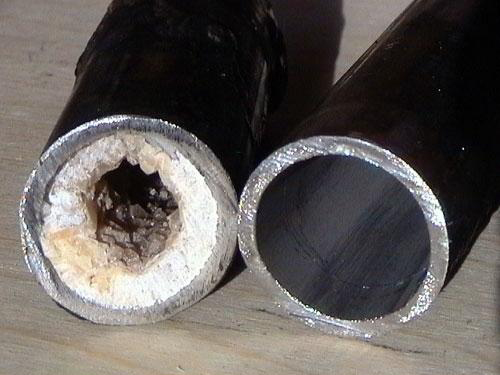
What does a blockage in pipes lead to?
Cleaning methods
If the pipe is clogged, you can use one of the following methods:
- thermal - the blockage is affected by the pressure of hot water;
- chemical - the resulting plugs are dissolved with special means;
- mechanical - debris is removed by means of a plumbing cable or by disassembling a siphon;
- pressure cleaning - a classic plunger is used.
One method or another is chosen taking into account the materials from which the pipes are made. So, plastic products can be damaged by a cable or boiling water, and the use of chemicals should be carried out in strict accordance with the manufacturer's recommendations.
The plunger remains popular, affordable and easy to use when it comes to figuring out how to clear a blockage in a bathroom, sink, or toilet. The device looks like a handle (wooden or plastic), one side of which is supplemented with a rubber nozzle. The principle of the plunger is that under the influence of strong pressure, the resulting debris begins to collapse and move along the pipe. Often, waste flows freely and is easily disposed of.
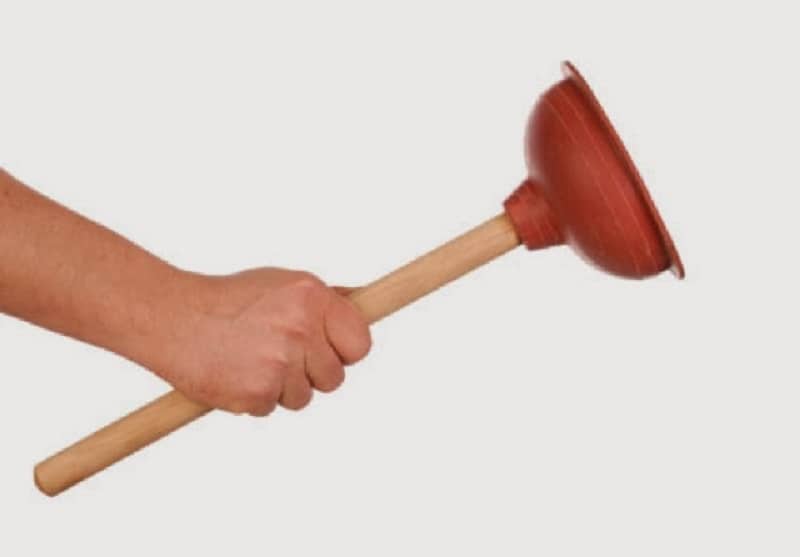
But even such a simple device must be used correctly:
- if the pipeline is supplemented with an overflow hole, it is recommended to close it tightly (a rag or lid is suitable), while the pressure on the formed plug will be reduced;
- the rubber part of the plunger is tightly pressed against the drain hole, after which progressive rhythmic movements begin. In this case, the rubber element does not come off the surface of the sink;
- with a sharp movement, the plunger is torn off the drain.
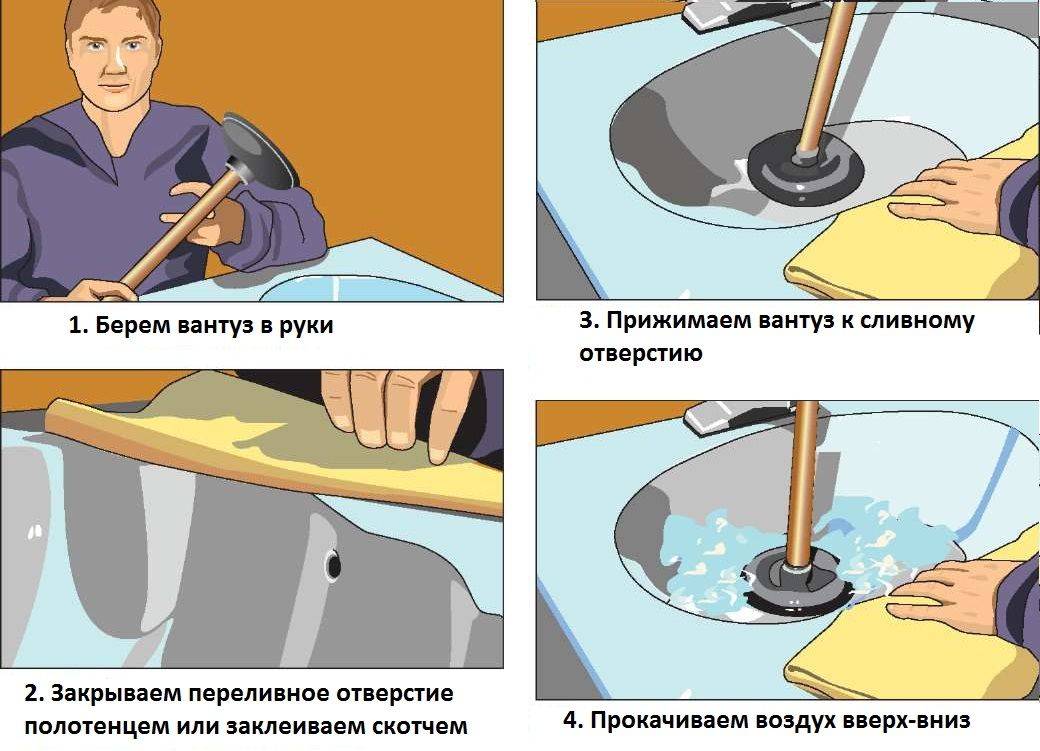
Technique for clearing clogging with a plunger
When working on a clogged plunger drain, it is important that the water level in the bathroom or sink is higher than the rubber valve. Repetition of the procedure will achieve the best result and completely eliminate stagnant water.
Household chemicals
When debris clogs up in the pipe, various chemicals will help to quickly and effectively cope with the difficulties that have arisen. Their use is good because there is no need for any physical effort - the active substance of the drug will independently remove the existing problem.
Such funds have a different consistency: liquid, powder, gel or foam. The principle of their use is as simple as possible: the volume of the cleaning agent recommended by the manufacturer is poured or poured into the drain and left for the time indicated on the label. After the allotted time, water is turned on, which will ensure a thorough flushing of the pipes.
The use of any chemical preparations requires special attention. Their contact with the skin or mucous membranes is not allowed (work is carried out in protective gloves). In addition, it is undesirable to get the product on the chrome-plated surface.
You should not wait for the moment when the pipes begin to clog, because such chemistry is excellent for preventive purposes: a small amount of a chemical gel or liquid is poured into the drain hole for literally a few minutes, after which it is thoroughly washed with hot water.

Chemicals
Folk remedies
Folk remedies are also good for clean sewer pipes. Such a blockage removal procedure is environmentally friendly, simple to perform and does not require financial expenses, since the main active ingredient is ordinary soda.

Folk remedies
The work is carried out according to the following scheme:
- soda and table vinegar are taken in the same volume (no more than one glass of each product);
- soda is first poured into the drain hole, on top of which vinegar is poured;
- the drain is closed with a stopper and left for about 3 hours;
- after this time, the pipes are thoroughly washed with boiling water.
Aromatic lemon is an effective folk remedy. To eliminate contamination in the pipe, take several large citrus fruits and squeeze them into the drain hole (the main thing is that the seeds do not get there). The exposure time to the accumulated debris is at least one hour, after which you can start using the sink or bathtub.
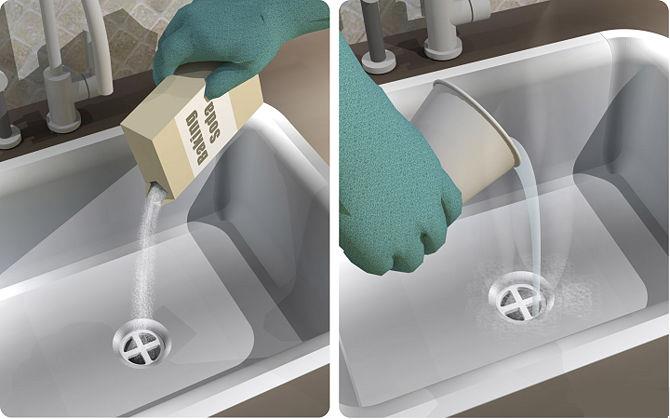
First, soda is poured into the drain, and then vinegar is poured
Cleaning the siphon
To cope with the problem of how to remove the blockage, it is often sufficient to clean the siphon. With this procedure, the order of actions will be as follows:
- the floor under the siphon is covered with a cloth that absorbs water well. So that the subsequent cleaning of the room does not take much time, it is better to place a bowl under the sink where the dirty water will drain;
- after the bolt nut is unscrewed, the flask is carefully removed. After removing the flask, water will drain into the previously substituted bowl, which previously served as a water seal;
- then the clogged siphon is thoroughly washed with water, and plaque is removed from its walls (for this purpose, chemical agents are used);
- after the completion of the procedure, the structure is reassembled. It is important to ensure that the drain pipe does not place emphasis on the siphon flask, as this will break the water seal;
- to check the tightness of the connections, it is enough to turn on a strong pressure of water.

Siphon cleaning instructions
Such cleaning will be useful as a preventive measure. Flushing the siphon no more than once every 2-3 months will minimize the appearance of a foul-smelling plaque on its inner walls, which causes an unpleasant odor in the room.
Using boiling water
If the blockage in the sink made itself felt unexpectedly, when there is simply no time to remove it, you can use a simple and often effective method - cleaning the pipes with boiling water. The effectiveness of the method lies in the fact that under the influence of high temperatures fat will dissolve, which is often the cause of most blockages.
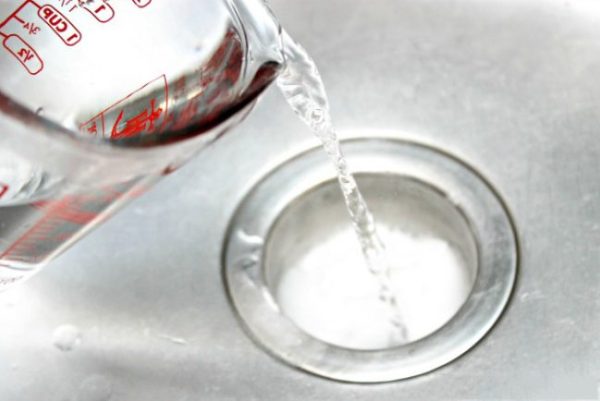
First, you need to determine the scale of the problem: if water has accumulated in one place (say, in a washbasin), then such a blockage is local in nature, and when water is in all the drains, such a blockage is considered global. In this case, the solution to the problem is to clean all sewer lines, while in case of local pollution, it will be enough to clean one pipe.
Boiling water may only be used if the plumbing system is made with metal pipes. The principle of operation is as simple as possible: heat up to 4 liters of water and pour it into the drain. If necessary, the cleaning is repeated. For maximum effect, you can use a brush or plunger.
It is better to refuse boiling water if the water collects on the surface of the sink or bathtub and does not leave. It is important to remember that boiling water in this case simply will not affect the problem area. In addition, you must be careful when using the plunger so as not to injure the skin with hot splashes. For plastic pipes, hot (but not boiling) water is suitable, into which washing powder is introduced in the proportion of 200 g of the mixture per 5 liters of water. The resulting solution is gradually poured into the clogged pipe.
Using a wire rope
Debris accumulated deep in the pipes is unlikely to be removed with the help of chemicals, boiling water or a plunger. Then you can resort to the plumbing cable for help. Such a cable looks like a thick twisted wire, one side of which is supplemented with a drill, and the other with a handle. The length of the cable is no more than 10 meters, which is quite enough to remove a blockage in the bathroom of an apartment or private house. It must be remembered that such a device is suitable for dealing with contamination of metal pipes.

Types of cables
To clean the drain with a plumbing cable, you should adhere to the following recommendations:
- first of all, the sewer pipe is disconnected from the siphon, after which the end of the wire is carefully inserted into the drain hole. If you have to deal with a modern sewer system, which is supplemented with special fittings for cleaning pipes, the siphon is left intact;
- that the cleaning process was as effective as possible, it will require 2 people to complete it - one of them will be responsible for the correct direction of the cable, and the second will directly clean the clogged pipe;
- when a place of pollution is found, the congestion is pierced with a cable with neat jerky movements;
- after that, the wire is removed, the pipe (if necessary) is collected and thoroughly washed with hot water.
If, during cleaning, the cable gets stuck in the pipe, it must be slowly rotated to the sides until it is possible to cope with the obstacle. The plumbing cable remains an effective solution to the problem of how to remove the blockage that has formed at the depth of the pipes on your own in a short time.
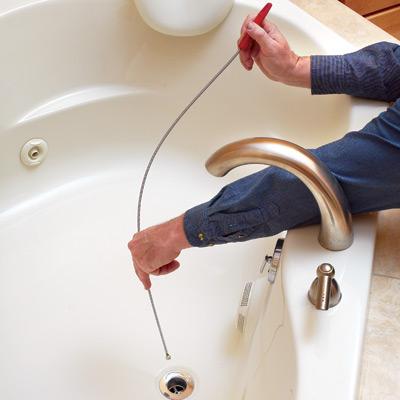
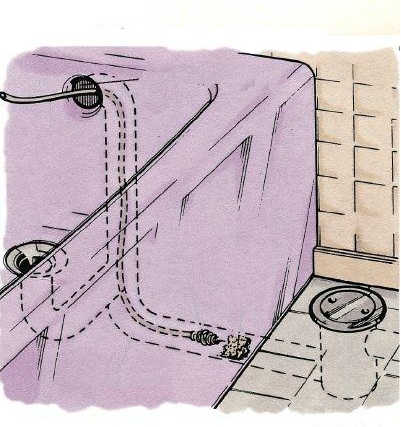
Cleaning scheme
Preventive measures
How often do we clean the siphon or treat the pipes from plaque? In order not to wait for the moment when the pipes of your apartment or house become clogged, you should adhere to simple tips for preventing such a problem:
- each drain hole should be covered with a protective mesh, thanks to which a minimum amount of waste will enter the pipes;
- once every few months, treat the domestic sewage system with appropriate chemicals that can dissolve accumulated debris, preventing it from forming plugs and impassable blockages;
- washing powder is an excellent substitute for such products. Once every 3 months, the drain holes of the bathroom and kitchen are closed, after which several glasses of washing powder are poured, hot water is turned on and the plugs are removed;
- in order for the sink in the kitchen to serve properly, it is enough to periodically rinse its pipe with hot water for 1-2 minutes;
- after each shampooing or taking a shower, it is recommended to clean the drain grate in the bath from accumulated hair;
- remember to clean the siphon to keep the pipes from getting clogged.
Such simple actions do not allow dirt to accumulate on the inner surface of the pipes, therefore, you will not have to worry about blockages. Especially if you know how to remove a blockage in the bathroom.
